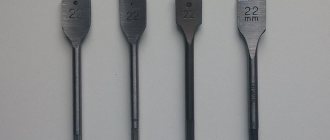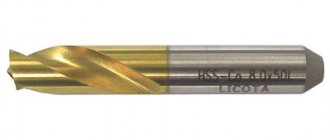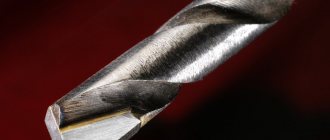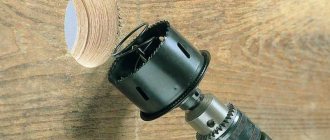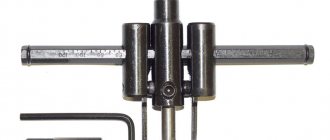To work with wood, you need to use high-quality tools. This is especially true for procedures related to drilling material. When choosing a suitable tool, take into account the type of wood and the diameter of the required holes. It’s easy to buy a good wood drill; there is a wide range of them on the construction market.
Areas of use and design features
The market for tools and accessories is full of a variety of wood drill bits to choose from. Woodworking tools are used in accordance with the specifications, design and type of work being performed. The functionality of one drill can be limited; under heavy loads it can break and damage the part. To eliminate curious cases, a wood drill is used in accordance with technical parameters.
A home craftsman must distinguish between varieties and types in order to perform the safest and highest quality work possible.
When purchasing, you should pay attention to the quality of the gimlet; the main structure and cutting part must be free of chips and cracks, well processed and evenly sharpened.
Based on the color scheme, it is possible to determine the treatment and purpose:
- A steel-colored product indicates a lack of processing.
- A yellow-bronze tint is obtained by metal during processing to relieve metal stress.
- The bright golden color indicates titanium nitride treatment, which is used for durability and reliability of the countersink.
- The strength of the tool is increased by superheated steam; the black color indicates this when purchasing.
An example of using a wood drill
It is necessary to pay attention to the size of the drill. A long wood drill is not always useful for the farm, since the longer the drill, the larger its diameter. Long gimlets are used for processing soft wood at medium tool speeds. The larger the size indicators, the lower the revolutions should be, because there is a possibility of the drill breaking off and damaging the workpiece.
It is necessary to correctly select the ratio of weight to the required hole. The greater the length and diameter of the wood drill, the lower the drill speed should be.
Compliance with this rule will help preserve the instrument for as long as possible. If a twist drill cannot produce the required hole size in wood, a ring type drill is used. The appearance of ring drills for wood resembles crowns and has a ring with jagged edges. The length of this type of product does not differ in special parameters, and the width of the outlet hole can be made up to 60 mm. The tool is also allowed to work with soft materials - plastic and plasterboard.
Description of types of drills for wood, how to make a hole in wood of large diameter
A wood drill is a tool that is constantly in use at home. Each type has its own characteristics.
The selection is made depending on the hardness of the material being processed and the parameters of the future hole. Attention is drawn to the absence of flaws that may be present in the drilling element.
There should be no scratches, dents or nicks on the surface. The presence of such defects will affect the quality of the final work.
Types of wood drills
Depending on the design features, types of wood drills are divided into several categories. The classification is as follows:
- spiral;
- screw;
- feathers;
- Forstner drills;
- crowns;
- milling;
- cork;
- combined;
- countersink.
They are selected depending on the thickness of the material being processed, the diameter and depth of the hole, and the type of shank in the tool.
Attention is drawn to the color of the drill, which changes with different heat treatment technologies:
- Black. In order to increase strength, steam treatment was used.
- Yellow-gold. Treatment was carried out in order to remove surface stresses from the metal.
- Bright gold. Using heat treatment, the surface layer was saturated with titanium nitride.
- Grey. The surface was not sprayed.
Spiral devices
Twist drills are more often than other types used at home. The tool is characterized by a low price and a wide range of diameters - from 3 to 16 mm. There is a point at the end. During operation, it gives it stability, eliminates the possibility of slipping and marks the point at the start of drilling.
Tips can be installed on top: conical or special trimmers. They have the same degree of efficiency, but the magnitude of the perceived load is different. The scorers transfer significant stress to the tool, but the holes are produced with a high degree of accuracy, while the conical head ensures that the drill enters the wood well, without the drill wandering to the side.
Screw (screw)
Another name for this type is auger drill. Due to the fact that the working area resembles an auger, waste is removed . Advantages:
- Long wood drill. The maximum size is 600 mm, although the most commonly used is 450 mm. Ensures drilling of holes in thick materials with high quality workmanship. Long drills are installed on electric drills and the low speed mode is turned on. It is important to remember that the smaller the diameter of the drill, the shorter it should be. Knowing which drill will be installed, the appropriate operating mode is selected.
- The range of diameter sizes ranges from 3 mm to 52 mm.
The drill must not be bent during operation.
Feather devices
The feather one has a central part made in the shape of a feather. 2 incisors diverge in both directions. On the other side there is a hexagonal tip . The operating rules are as follows:
- Before starting work, use a core to mark the drilling location.
- The equipment used is an electric drill. The number of revolutions is set depending on the diameter of the drill. The larger it is, the lower the revolutions.
- When drilling a deep hole, an extension is used, which is attached to the drill with a lock.
- At the first stage, the contour of the hole is outlined. To do this, the feather part is positioned perpendicular to the surface and pressure is applied with little force.
- Chips are not removed from the groove on their own, so work must be stopped from time to time to remove them.
The tool is the easiest to maintain. Its sharpening is carried out according to the sample. The main thing is to sharpen the central part exactly in the axis. A slight displacement will cause the drill to the side.
Forstner drills
The advantage of this type of drilling is the cleanliness of the cut. This is achieved by cutting the fibers around the circumference before starting work. , chips and scuffs form on the treated surface
The tool clearly holds the given direction. In general, as a rule, all drills fix the drilling point with a central tip. Forstner drill - through a cylindrical plane. Thanks to the large surface, the drill cannot move to the side.
A variation of the Fostner drill is the ballerina drill. It consists of a centering element and lateral incisors. Thanks to the adjustable device, the required diameter is set. There is no need to purchase a new tool.
Crowns
Crowns (ring hole method) is the most silent method. It is used when you need to make a large hole in a workpiece of small thickness. The diameter can vary from 19 to 127 mm. Nozzles are sold in sets.
The specificity of the work allows you to drill holes in drywall, fiberboard, chipboard and plastic. The disadvantage is the unreliability of the design. The crown is made of metal 2 mm thick. This allows you to drill no more than 2-3 holes. After this, it is no longer suitable for work.
Milling drills
Using milling drills, you can not only drill holes, but also make grooves. Therefore, they are used in complex machining of parts. The design of the drill consists of a shank and a working part, which is immediately sharpened for the required operation.
The tail section comes in different configurations:
- Triangular. Suitable for three jaw chuck. The shank does not rotate even with high torques.
- Hexagonal. Installation is carried out both in a three-jaw chuck and in a standard one. There is a risk of twisting.
- Conical. For use in production only.
- Tetrahedral. They are rarely used, although there is no turning effect in the cartridge.
Stopper devices
The tool is adapted for making holes for wooden plugs. The holes in which defects have formed due to fallen knots are being processed. In furniture production such defects are unacceptable. Sometimes work is carried out to make countersunk holes in wood for washers or bolt heads.
The plug drill has a cylindrical or conical shape. Installed on a drilling or manual milling machine. The drill cannot be used because the perpendicularity condition will not be met.
Combined type
Using combination drills, stepped holes are made. The number of steps ranges from 2 to 3. A regular twist drill is taken and the sections are ground to a new diameter. Resharpening is allowed for a small difference.
If the range of diameters is impressive, then drills are used that have an alternating cutting edge. A large number of resharpenings are possible here.
Countersink drills
If you need to hide the bolt head in a wooden structure, you can use drills of different diameters. However, it is advisable to combine 2 actions in one.
The design consists of a housing in which the countersink is located. The main drill is attached inside. During the work process, the main hole is first made. In the final stage, they are formed in the upper part of the trench.
Getting a Big Hole
Home craftsmen are often interested in how to make a hole in a tree of large diameter. There are several ways you can do this:
- A circle of the required diameter is drawn. A small drill is used to drill inside the circle of holes. Then, using a chisel, the jumpers are cut out.
- Take a water pipe. One side is sharpened for teeth in the direction of the cut. In the second, a hole is made for the knob. The pipe is placed against the surface and slow rotation begins.
- At the first stage, a through hole of smaller diameter is drilled. At the second stage, a crown is taken and inserted to the maximum depth. At the final stage, the under-drilled wood is knocked out with a chisel. Chips will not occur because the crown has already set the direction.
Wood drills have a broad classification. This is an important item at home. However, each type of work requires the use of a specific tool. With the help of one, holes are made, the other - countersinks, the third - grooves. Knowing all these subtleties, it is necessary to have sets of such drills that will never lie around the household.
Source: https://chebo.pro/stroyka-i-remont/sverla-po-derevu-dlya-otverstij-vidy-i-klassifikatsiya.html
Selecting the required type of drills for a home workshop
The sets of tools for woodworking included in power tools are not very diverse. Therefore, for comfortable work, you select your own set of tools, depending on the type and material of the work. Wood drills are divided into types, depending on the type and hardness of the material. It is necessary to choose a high-quality wood drill; the main characteristics should differ in conditional parameters.
Spiral
The most common type are twist drills for wood.
Spiral
Different diameters from 3 to 50 mm allow you to perform a different range of work; the pointed end is necessary for balancing the electric drill. A cone-shaped shank is used in cases where it is necessary to adjust the drilling point. It is worth taking into account the hardness of the rocks and the diameter of the gimlet when making parts. For example, with a drill with a diameter of 12 mm, it is possible to drill soft material at a speed of about 2000 per minute, when with hard rocks the speed is halved. Using the woodworking kit in accordance with the technical regulations and for its intended purpose can extend the service life and maintain the sharpness of the cutting element.
Long drills
Drills of unique and different lengths are used in non-standard situations; it must be taken into account that the longer the length, the larger the diameter.
Long wood drill
The increased length can cause the tool to be heavy; a conventional electric drill is not able to rotate a heavy shaft. To drill lengths with a drill, a mixer is used - a stirrer operating at low speeds with low force.
Screw
A subcategory of spiral products are screw drills. The drilling process occurs by drilling against the growth of wood fibers. The screw drill also comes in different diameters, lengths and weights. For example, a wood drill with a diameter of 4 centimeters will have a length of 600 cm and a weight of just under 1.3 kilograms. A design feature is the presence of a threaded screw, which allows the removal of wood chips. The threaded tip is used for precise installation of the tool when working with materials.
Wood screw drill
It is important to understand that a smaller drill diameter cannot be associated with an increased length of the product. There are narrow and long versions of the tool on the market, but a reliable process cannot be achieved with them due to the fragility of the material and the wrong choice of power tool speed.
Feather
The most balanced in weight and design is the feather type. The accuracy and quality of processing will not have high parameters, so this version of the gimlet is not applicable for decorative work.
Feather
Work is carried out at increased speed due to the lightweight design and simple adjustment. The hole width range can vary from 10 to 60 mm, depending on the type of structure. The length of the treated surface can be adjusted with a special adapter - an extension, which allows you to increase the depth to 30 centimeters. The process must be carried out without stress on the tool, since the drill can break when heated, due to its fragile design.
Forstner drill
Blind holes for fastening hinges, handles and other accessories are made using a Forstner drill. The cutting edges are located on the side plane, making it possible to process holes with a flat bottom. The main difference of the kit is that it does not heat up during operation and is capable of performing precise work based on the correct direction of drilling. The dimensions and diameter of the holes depend on the choice of instrument; an analogue of this type of instrument is a ballerina.
Forstner drill
The ballerina allows you to adjust the diameter of the future hole in the tree, thanks to a special mechanism. Buying one universal tool when working with wood can replace a whole set, and is convenient for storage and transportation.
Ring
The annular type of drills allows you to make large-diameter holes, also called crowns. The appearance implies a ring with jagged edges along the entire edge. It is common to use sets in which there is a different choice of equipment according to diameter.
Wood drill bit
The guide bur is located in the center of the disk, then there is a mechanism for attaching removable tips. The universal set allows you to process thin-walled products and materials.
Countersink
Drilled holes for connecting elements, bolts or screws, often need to be masked. The countersink is used in conjunction with a depth limiter for proper processing of wood.
Countersink
A replaceable centering tip for wood with a diameter of 4 mm is fixed using a clamping mechanism with a screw.
Flexible
It should be noted right away that the drill material cannot be flexible and has not yet been developed. The name of a flexible tool for work is a mechanism inserted into a cartridge, a kind of extension.
Flexible wood drill bit in use
The use of an adapter allows you to transfer the torque of a drill or screwdriver to a drill located in a hard-to-reach place. Varieties of small length and diameter are used; the design will not withstand a massive woodworking tool.
Main types
The main parameter, depending on which wood drills are divided into different types, is the design of the working part. Based on this feature, wood drilling tools may fall into one of the following categories.
Feather
Drills of this type are used to make holes of medium diameter in wood - up to 25 mm. It is advisable to use such a tool in cases where the requirements for the accuracy of geometric parameters, as well as for the quality of the holes, are not too strict. Among the most significant advantages of pen drills, low cost and ease of maintenance should be noted.
Feather drills are considered the most affordable
Core drills
Core type tools are designed for drilling large diameter holes. In terms of their design, wood crowns resemble a metal glass with a shank, the working end of which has cutting teeth. When such a drill rotates, its cutting teeth, interacting with the workpiece, cut out a circle of the required diameter on its surface.
Set of wood crowns
Spiral
Spiral wood drills are also called screw drills. Their working part resembles a screw. They are used for drilling small diameter holes in wood. Due to the special design of screw-type drills, chips are effectively removed from the processing area when used. The twist drill also ensures high precision and extremely high quality machining.
Spiral wood drill with scoring
Forstner
These are tools that are used to create not through, but blind holes with a perfectly flat bottom in wood products. In addition, if you use such a wood drill with additional accessories, you can drill a square hole in a wooden product.
Many modifications of Forstner drills are produced.
Milling
With the help of such tools, it is possible not only to drill wood, but also to make grooves of various configurations in wood products. Drills of this type are most often used in cases where it is necessary to perform complex processing of wooden parts, and in order to drill a regular hole, a twist drill, a feather or a core tool is used.
Milling drills are designed for drilling a round hole and then boring it to the desired shape. Used when working with wood and thin metal
The shank of drills designed for woodworking is usually cylindrical, but manufacturers also produce them with shanks of other configurations. So, on the modern market you can buy drills for woodworking, the shanks of which can be:
- triangular, optimally suited for fixation in a three-jaw chuck (tools with a triangular shank are ideally transmitted torque, and even very significant loads are not able to turn it in the chuck);
- hexagonal (tools with such shanks can be installed in both a standard and a three-jaw chuck, but there is a very high risk of the drill turning when subjected to heavy loads);
- conical (tools with shanks of this type are used primarily to equip production equipment);
- tetrahedral (a rarely used form of shanks, which, however, ensures high stability of the tool against rotation in the chuck).
Advantages and disadvantages
Each cutting set is designed to perform specific jobs under different operating conditions of the equipment.
Before processing wood, it is important to evaluate the type of hole required and the material. Properly performed preparatory work and the use of tools allow you to obtain high-quality results and durable operation of the devices.
The functionality is described in the instructions or on the product packaging; if there is no information, you must contact a specialist for clarification on the technical data.
How to drill a long hole in wood
All photos from the article
If you need to make a large diameter hole in a tree, you will have to use special devices, each of which has its own characteristics. We will consider all possible options and tell you about their main advantages and disadvantages so that you can choose the best option in accordance with the specifics of the work in a given situation.
In the photo: equipment for wood differs from equipment for concrete and ceramics
Features of wood drilling work
There are a huge number of products offered on the market. The varieties do not stop at the list presented; for example, to obtain conical tenons, plug-type drills are used. Holes in wooden structures can be made with any available material, even a milling cutter or drill.
Drilling technology depends on the thickness and density of the material. Usually the work is carried out initially with a drill of a smaller diameter to prevent chipping on the back side of the product. The process is preferably carried out on both sides according to the prepared markings. When this opportunity is not provided, a wooden beam is placed at the point where the drill exits the workpiece. To obtain the necessary recesses, the marks necessary to visualize the process are applied to the cutting element.
What is the diameter of the drill bit for the self-tapping screw?
What materials are commonly used at home? Items made of wood, metal, plywood, drywall - their installation is not complete without the use of self-tapping screws. Of course, without practice, you can bend the screws and break them, all due to lack of knowledge on how to work with these fasteners. Therefore, it is better to learn in advance how to screw in self-tapping screws.
Fastening elements are divided into many types. Most often there is a division into “for metal” and “for wood”. They differ from each other even in appearance. The difference lies in the thread ball, that is, the distance between the threads. The thread of self-tapping screws for wood has a larger distance between the turns of the thread (for metal there is a smaller distance).
If you confuse the screws and screw the screw into wood, for example, into a sheet of metal, the fastening will either bend or even break. A self-tapping screw for metal in wood will not hold at all, since the wood will not penetrate between the turns and actually does not hold.
As for self-tapping screws for metal, you can find 2 varieties - with a drill at the tip and without.
Drill diameter for wood screws
It is quite easy to identify a self-tapping screw for wood - it has a large distance between the turns (than a self-tapping screw for metal). Why is that? The reason is quite simple - wood is a less dense material than iron.
Such screws can be of different colors - black, white, gold. The color does not affect functionality, that is, this is not some kind of special marking, but simply different colors for selecting fasteners to match the color. Of course, if you have white furniture, then it is better to use a white screw.
It is impossible to determine by the colors what this self-tapping screw is for wood or metal, only by the distance of the thread.
Self-tapping screws can be of different lengths and you need to choose according to your tasks; there are the smallest ones - a little more than a centimeter long and there are long ones, more than 20 centimeters long.
Black screws are usually 3.5 and 4.2 millimeters in diameter. And yellow ones - from 2.5 to 5.5 millimeters.
Of course, there should be no problems with soft wood, but with oak or acacia there may be difficulties (plus do not forget that the wood can split). Therefore, in order not to spoil the entire structure, it is better to first drill a hole of a smaller diameter in the material. The cap needs to be sunk flush into the material (to do this, pre-drill a recess with the same diameter as the cap).
If the diameter of the self-tapping screw is small, pre-drilling is not necessary, but if the diameter is more than 4 millimeters, then you need to pre-drill with a drill 0.5 - 1 millimeter smaller than the self-tapping screw itself.
Read also: How to make a 220 volt diode bridge
Diameter of drill for metal self-tapping screw
If the metal that needs to be drilled or screwed into metal is less than 0.5 millimeters thick, then there are no problems, you don’t even need to pre-drill it. But if the metal thickness is greater, for example 0.8 millimeters or 1 millimeter, then you must first drill a hole for installing a self-tapping screw. Typically, the thickness of the hole being drilled depends on the thickness of the material. If you guess the size of the drill, then you can tighten the self-tapping screw even with a regular screwdriver.
Below is a table of recommended drill diameters for a certain metal thickness.
The most common drill diameter is 3.4, the others are less common.
In the case of self-tapping screws (+ press washer) up to 1.5 mm of metal thickness, you don’t have to drill a hole, but above that you can’t do without it, since the drill itself made from a self-tapping screw can’t do the job, it’s almost useless.
Correspondence table between drill diameters for sharp self-tapping screws and metal thickness
The table data may change a lot due to:
- The quality of the material itself;
- Quality of self-tapping screws;
- Screwdriver power;
- What kind of reliability is needed for fastening?
So, in general, if you have thick, dense wood or a thick sheet of metal, you first need to drill it (smaller in diameter than the diameter of the screw) and then screw it in.
Reading time: 7 minutes No time?
Self-tapping screws for wood are hardly inferior in popularity to any other fastener. Without them, durable wooden furniture, frame supports, doorways and many building structures, including drywall, would not exist (by the way, if you have ever looked for special fasteners for these purposes, there are none). A self-tapping screw is a reliable, but at the same time simple and affordable tool. Today, in a review by the HouseChief.ru editors, we will talk about how to choose the right wood screws, and tables with sizes and prices will help you navigate their diversity and choose the right option for a specific type of work.
Read in the article
Sharpening a wood drill is a useful skill
Intensive use of wood tools leads to loss of its cutting properties. Such a tool does not have to be sent for recycling; its ability to work can be restored by proper sharpening. In the absence of experience and small volumes of tools, it is possible to contact special workshops that provide sharpening services. To study the process on your own, you need to start with an unused drill, which, if damaged, can easily go to waste.
Methods for sharpening drills
A device for sharpening drills at home
Head position when sharpening
Obtaining a result is possible only if several conditions are met. The process is carried out manually, using a suitable file or using a grinding machine. In the latter case, it is necessary to maintain the temperature regime of the product, constantly pouring a stream of water or oil. Overheating will lead to loss of metal strength, unimportant work, in the absence of the ability to provide constant cooling, you just need to dip the product in a glass of water or oil every couple of seconds. Only compliance with the factory geometry parameters will make it possible to operate the cutting set as if it were in new condition.
